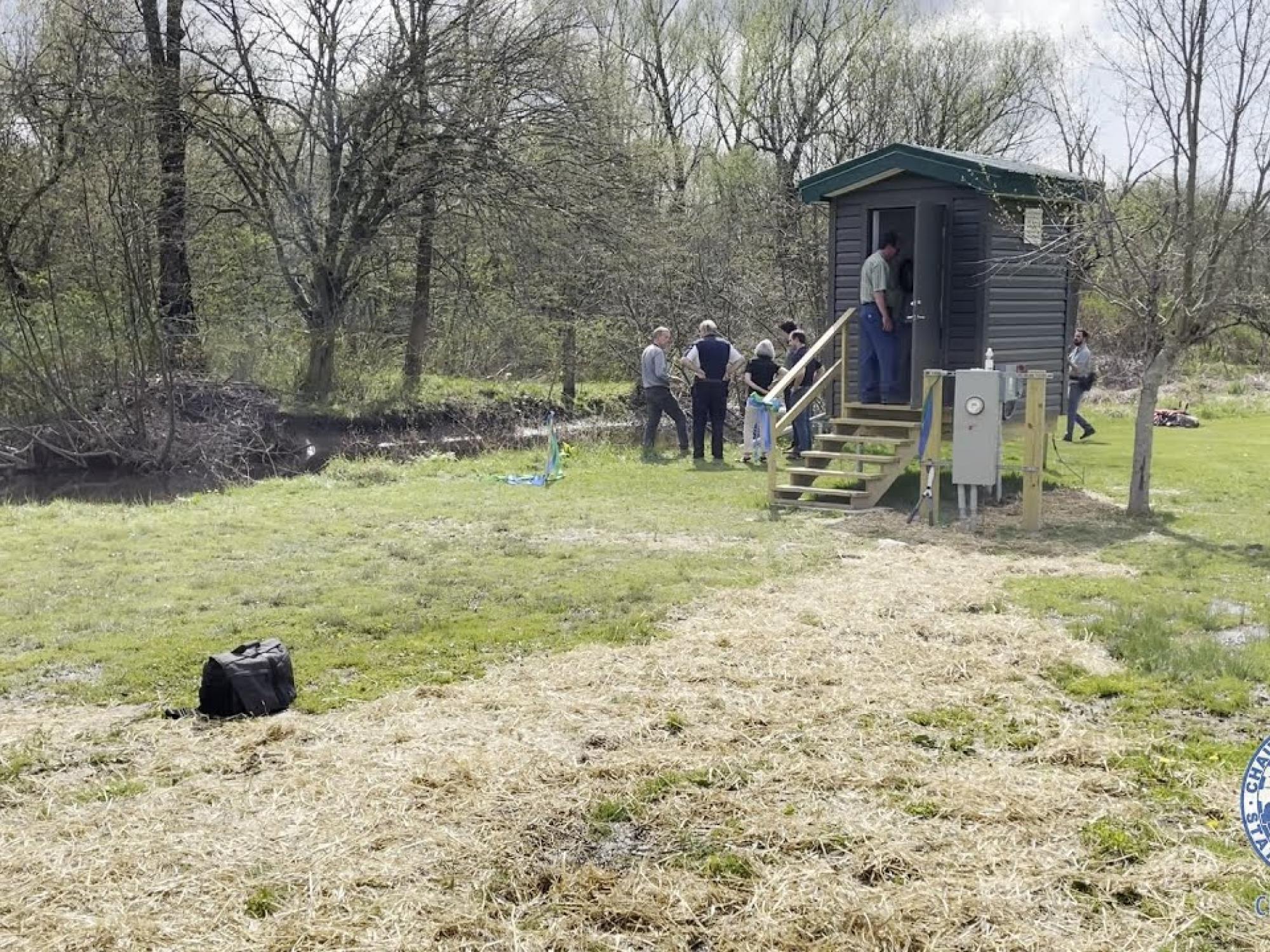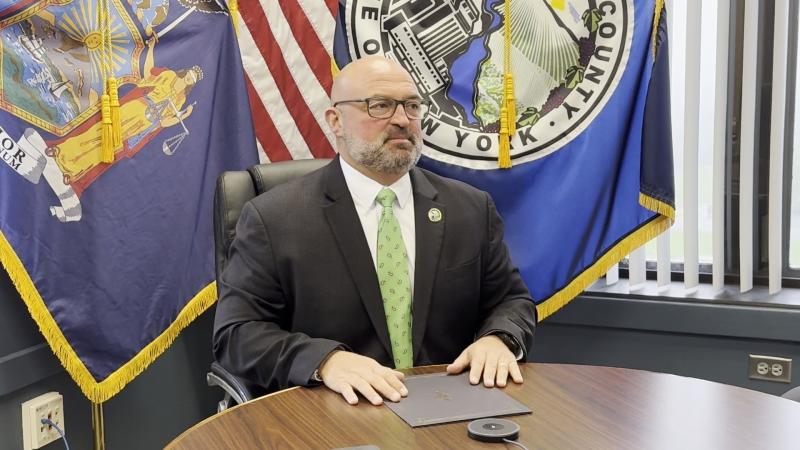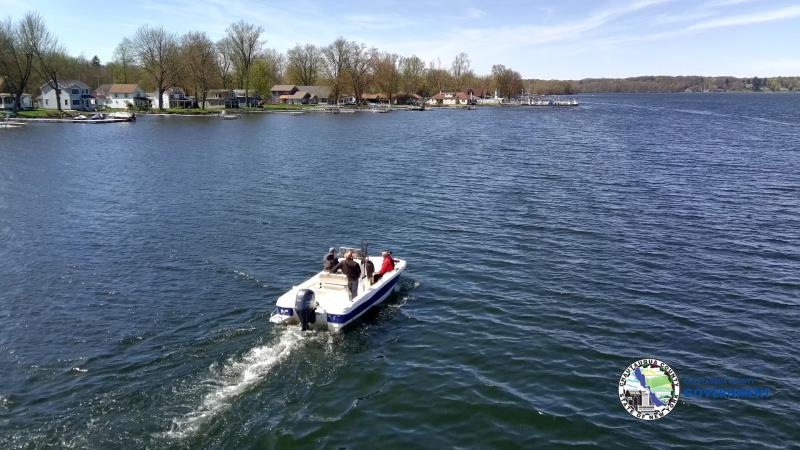By Jay Young, Chautauqua Lake & Watershed Management Alliance
MAYVILLE, NY – The spring bloom is bringing with it major advancements in Chautauqua Lake’s science towards solutions approach.
A diverse crowd of project partners and stakeholders gathered on the banks of Mud Creek in Mayville on Monday, April 29, 2024 to celebrate the unveiling of a new stream monitoring network. The Mud Creek station is one of six constructed as part of the research partnership between The Jefferson Project and Chautauqua Institution, which began working on Chautauqua Lake in 2020.
Taking and adapting its blueprint from ten years of work on Lake George, The Jefferson Project has rolled out its Chautauqua program in several stages. The latest step in this rollout is the construction of six tributary stations, which will collect important information about the waters feeding our lake. Stations are scheduled to be operational this year on Dewittville, Mud, Prendergast, Ball, Bemus, and Goose Creeks, while a seventh station will monitor flow in the Chadakoin River. Stantec Consulting Services has served as the technical lead during the construction process, and TimberHut Cabin Company of Great Valley provided the pre-fabricated structure of the stations.
Monday’s event was introduced by Chautauqua Lake and Watershed Management Alliance Executive Director Randall Perry, and included remarks from representatives of the many different organizations that have made this expansion of research possible.
“We are very honored to have people from across the spectrum,” Perry said. “We’ve got governmental leadership, philanthropic leadership, we have scientific and engineering leadership from not just The Jefferson Project team and the core group that built this but from across the scientific fields and stakeholder fields. It takes all of us.”
Following Perry’s introduction, Institution President Dr. Michael Hill spoke about the inception of the partnership with The Jefferson Project, and the progress that has been made to develop science-based solutions to the impairments we face on Chautauqua Lake.
“It is amazing to think that when completed, Chautauqua Lake will be one of only two fully computerized lakes in the world,” said Hill. “Through a system of sensors and measuring devices tied to (weather) events, modeling computer systems created by IBM, Chautauqua Lake in our backyard is on the forefront of some of the most advanced freshwater lake research technology in the nation. Which is just stunning to think about.”
Funding for this project was provided by the Ralph C. Sheldon Foundation via an Alliance pass-thru grant that was secured in the summer of 2023.
“The Sheldon Foundation has long supported and been concerned about the health of Chautauqua Lake,” Executive Director Linda Swanson said. “We had an unusual opportunity last year to give a pretty significant gift for our foundation, and we remain committed to the future. All along this was the missing link to the (nutrient) budget of the lake. We made great strides with the scientific work that was done in-lake, and just didn’t really know what was happening with the water coming from the tributaries. Now we will have the technology to do that.”
County Executive PJ Wendel took the opportunity to look back at the many different pieces of funding and community collaboration that have been necessary to get to this point.
“It’s a great community partnership, Brooks Anderson owner of TimberHut has been a longtime friend of mine,” Wendel said. “A unity of effort is a phrase that I have been following when it comes to Chautauqua Lake, and that is going to continue. We need to work together. We now are working with the state, which is a great partner, but we need more. So we are going to continue this effort together, we are going to continue to bring the science, and we are going to push to make that healthy lake one of the smartest lakes in the United States.”

(Pictured above, Dwight Harrienger of Stantec cuts the ribbon on the new Mud Creek stream monitoring station in the Village of Mayville. Pictured, from left, are Mayville Mayor Rick Syper, County Watershed Coordinator Dave McCoy, County Legislature Chairman Pierre Chagnon, Hans Auer and Linda Swanson of the Sheldon Foundation, Chautauqua Institution President Dr. Michael Hill, and County Executive PJ Wendel. Photo by Dave Munch of Chautauqua Institution.)
Philip Gow, representing Congressman Nick Langworthy, and George Fillgrove, representing state Senator George Borrello, offered congratulations to all those involved with the project and expressed support for the expansion of projects helping to improve Chautauqua Lake.
Following statements by local stakeholders, members of the construction and research teams took to the microphone to explain in detail how these stations were built and their operation. Speakers included Dwight Harrienger and Rose Richelsen of Stantec, as well as Vince Moriarty and Mike Kelly of IBM Research and The Jefferson Project.
“I want to not forget to thank the landowners who have agreed to have stream stations placed on their property,” Harrienger said.
During the site selection process, Harrienger and his team worked with property owners to secure locations for the stations at each major tributary. Environmental sustainability has also been an important goal during this project, and the stations have been designed to be mobile and leave minimal impacts at each site.
“The farthest pipe from us right now is holding what we call a sonde,” said Richelsen. “Which is just a large instrument that will take different water quality parameters, it will take those measurements.”
While stream sampling has been done in the watershed in the past, these new stations have the capability to measure several different water quality variables instantaneously. The sondes described in detail by Richelsen are able to measure things like temperature, flow, and salt content and store that data for future computer modeling.
The stations can also directly pull water samples remotely for further analysis during storm events, and are equipped with weather stations. Once again following the model of their research on Lake George, these facilities are operated by a computer control panel running specialized software. Data streams from each of these control panels are brought together in an environmental model that has been developed by IBM Research.
“It is a very custom interface. So every single one of these sensors we write custom software, we are then running it on our computer in that box,” said Moriarty. “Adaptive sampling is when we take sensor data, take model data, and decide when we want to take a sample. So if the sensors say hey, there is a lot of chloride (salt) coming through right now, we can take a sample right now or take ten samples and get a whole range.”
Moriarty explained that observations from Lake George indicate a large amount of the chloride entering that lake can often be traced to a relatively small number of weather events. That is the type of scientific insight that is made possible by the adaptive sampling that will now be taking place in the Chautauqua watershed.
“This stream station, this is all well and good. If it was here by itself it would be great,” said Kelly. “As Vince mentioned, it is talking to a bunch of other what we call endpoints. Other environmental measurement stations. It’s not really about this stream, it is about the lake.”
Kelly indicated that the main goals of this research program can be summed up with three questions: Where are the nutrients coming from? If it is from streams, how does that water enter the lake? How does that nutrient-laden water then interact with the ecosystem?
“This stream station is going to help us answer the first two questions,” Kelly said.
Following the afternoon’s presentations, those in attendance were given the opportunity to view the interior of the station and discuss more details of the program. Also present for the event were Town of Chautauqua Supervisor and Alliance Board Vice-Chair Don Emhardt; Chautauqua County Deputy County Executive for Economic Development and County of Chautauqua Industrial Development Agency CEO Mark Geise; John Shedd and Geof Follansbee of Chautauqua Institution; Damianos Skaros and Lawson Fenton of NYSDEC; Amanda Stone of Stantec; Dr. Allison Hrycik of Rensselaer Polytechnic Institute and The Jefferson Project; Dr. Courtney Wigdahl-Perry of the State University of New York at Fredonia; Doug Conroe of the Chautauqua Lake Association; Jane Conroe of the Chautauqua-Conewango Consortium; Alliance Project Manager Taylor West; staff from TimberHut; and Village of Mayville Department of Public Works Superintendent Dan Engdahl. Helping to catalogue the unveiling were Jill McCormick and Dave Munch of Chautauqua Institution, and County Media Information Officer Justin Gould.
For more information about this project and others, please contact Alliance Communications Coordinator Jay Young at jyoung@chautauquaalliance.org or 716-661-8918.









